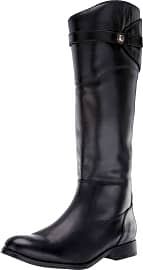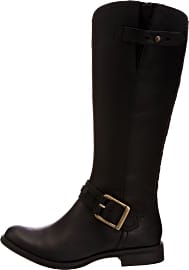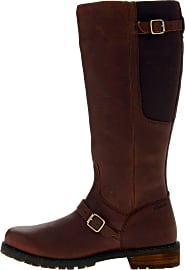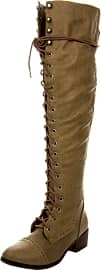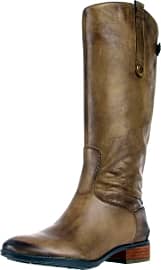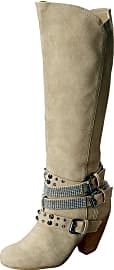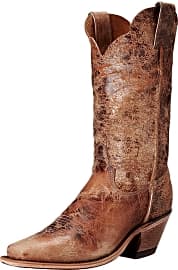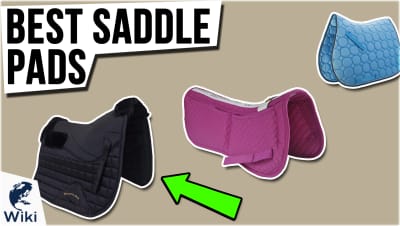The 10 Best Women's Riding Boots

This wiki has been updated 39 times since it was first published in April of 2015. Whether you compete in equestrian events on a regular basis or simply love the look of this classic style, you'll find the right pair of women's riding boots on this list. They all feature a slimming cut and many are available in multiple colors to suit your style. We've made sure to include options that can take a beating, as well as more affordable designs best suited to casual wear. When users buy our independently chosen editorial choices, we may earn commissions to help fund the Wiki.
Editor's Notes
March 28, 2020:
Riding boots were developed to keep riders' legs from chafing against the saddle and to keep their feet from slipping through the stirrups. Of course, today, many non-riders choose to don this style of footwear just for the classic look. The pairs we've picked out are mostly made from leather, though vegan-friendly options are featured here as well. We've made sure to include both lace-up and pull-on, in addition to zippered, designs to accommodate users who are concerned about calf circumference. Several of these have stretch panels of some kind, too.
In terms of style, you'll notice that some of the boots in this collection have modern embellishments like studs, distressing, and decorative seams, while others have a more traditional, sleek design. The Sam Edelman Penny, for example, is appropriate for actual riding and has the show-ready appearance to match. On the other end of the spectrum we have the Not Rated Cocktail Queen, which may not be the most practical choice for competing, but will definitely garner compliments at work, or during a night out on the town.
With regard to updates, the Frye Valerie and Caterpillar Corrine were removed from the list due to confirmed issues pertaining to fit and durability. In their place, the Frye Molly and Tommy Hilfiger Shyenne have been added, chosen because of their stylish designs and high-quality constructions. For these reasons they've been awarded the first and third slots. If you're on the hunt for knee-high footwear that can stand up to the elements and keep moisture and mud out, you might consider investing in a pair of rain boots instead.
Special Honors
Cole Haan Ivy It may look flat, but the stacked heel actually measures one inch in height, giving you just a little boost. The footbed boasts ample cushioning, which makes this a good pair to have in rotation for anyone whose job requires frequent standing and walking. dsw.com
Stuart Weitzman 5050 A favorite among celebrities — and it's easy to see why — this chic boot extends above the knee for a super-modern, stylish silhouette. It's incredibly slimming and has a pull-on design that makes it easy to get in and out of quickly. The lining is soft leather. zappos.com
Michael Kors Branson This boot doesn't just offer style, but comfort, too. It features a stretch panel that runs from the ankle up to the back of the knee. If you happen to have muscular calves, or if you just want the feeling of soft material against your skin as opposed to leather, this may be the perfect option for you. michaelkors.com
Women's Riding Boots: Blending Fashion and Function
For the rider who experiences truly dirty, demanding terrain in the course of her work or her play, synthetic materials may be the best choice.
Horseback riding is one of the most energizing and satisfying hobbies a person can enjoy, and it is an activity enjoyed by both genders alike. Interestingly, many equestrian experts posit women are actually better-suited to mastering horse riding, for reasons both anatomical and temperamental.
Riding is a costly pursuit, with the expenses of owning a horse or paying for the privilege to ride another's animal quite high in most cases. Those committed to horseback riding, therefore, tend to be a discerning group, and are careful in their selection of all manner of gear and accoutrement. One of the most important pieces of equipment a rider must buy is her boots. Boots protect the rider's feet and lower legs, and they are a primary contact point with the mount in terms of direction and control.
As it happens, riding boots are one of those rare accessories where a piece of clothing that must first and foremost be functional can also be attractive and stylish. Whereas it's almost impossible to conceive of a stylish hardhat or a flattering pair of work gloves, a pair of riding boots can serve its purpose while also accentuating a rider's sartorial tableau.
A woman must select riding boots that will fit her well, and that goes beyond choosing boots with the right shoe size measurement. Some boots are designed with tall, slender uppers that will grip a rider's calves and allow her to exert maximum control during a show or race, but that might not be comfortable for casual riding or for use during work on a ranch or farm. Other boots have wider uppers that can accommodate a thicker, muscular leg without feeling tight. The rise of the boot is a critical factor in terms of comfort, protection from the elements, and ease of donning and removing the footwear. The shape, size, and general design of a boot should be the first factors weighed.
When it comes to considering the right materials for your boots, you should first consider your riding environment, and later think of looks. If you will wear your boots as you trudge through muddy fields or corrals, or if you ride in the rain, through streams, or where mud spatters up from the horse's hooves, then suede riding boots are a poor idea. Mud and splatters are easily cleaned off of stiffer polished leather boots. Most leather boots are suitable for use in occasional rain, but are ideal for drier, sandy environs, as you can wipe dry dust and/or dirt off of leather in seconds. For the rider who experiences truly dirty, demanding terrain in the course of her work or her play, synthetic materials may be the best choice. Many riding boots made with synthetic fabrics and rubber can be hosed down or even machine washed, so you need not fear any amount of dirt, dust, mud, or dung.
Finally, once you have identified the riding boot shape and materials that suit your preferences and circumstances, by all means choose the pair you simply like to look at the most. For some riders, this will be a classic cowgirl style of boot with thick heels and pointed toes that slide easily into stirrups; for others it will be a tall and slender English-style boot that enhances the contour of the leg. Still others will appreciate the addition of semi-decorative, semi-functional hardware such as polished buckles and rivets.
Other Accessories the Female Rider Needs
There is one piece of gear all riders, regardless of gender, should always wear when riding a horse, and that is a helmet. Few horseback riding helmets are all that stylish, but that's of no matter: when your helmet protects you from injury caused by a fall or by impact with a low-hanging branch, it is performing its one and only duty.
That helps to accentuate the shape of the leg even while helping a horsewoman ride properly.
Riding pants, on the other hand, have the benefit of being flattering and functional, much like a fine pair of women's riding boots. Proper riding pants fit snugly, gripping the natural curves and musculature of the rider's legs to ensure she has maximum control over her mount. That helps to accentuate the shape of the leg even while helping a horsewoman ride properly. Most riding pants have leather (or synthetic fabric) patches attached to the inside of the pant legs, and these offer protection against abrasion while having minimal effect on appearance, as the patches are not visible when the rider is mounted.
As riding can be hot and sweaty work, a light shirt that promotes airflow and wicks moisture away from the skin is a must-have for warm weather riding. However, a garment providing some wind breaking is also often advisable, as the rider perched atop a horse has nothing to protect her from a chill breeze that can stir up unexpectedly, even on mild days.
Finally, take the comfort of both yourself and your horse into consideration with a fine saddle pad. A good saddle pad can help keep both you and your horse cooler by providing ventilation between the animal's body and the saddle, and can absorb the impacts caused by your rising and falling. Many saddle pads are designed to be small and fitted just for the actual saddle, while others are larger and will be more readily visible, giving you yet another chance to define your equestrian style.
Why Women Once Rode Sidesaddle
Today, it is entirely normal to see a woman decked out in form-fitting, functional equestrian gear and seated astride her mount, gripping the horse with both legs just like any male rider would. This has only been a generally-accepted practice for about a hundred years, though.
The sidesaddle positioning had nothing to do with logic or comfort, and everything to do with convoluted social constructs.
For centuries, women in many cultures were obliged to ride sidesaddle, with both legs draped over one side of the horse. There are even urns and amphorae from Ancient Greece that depict females in this decidedly awkward posture. And countless examples of Medieval art show women sitting sidesaddle on their mounts, which are often being led by men.
The sidesaddle positioning had nothing to do with logic or comfort, and everything to do with convoluted social constructs. For centuries, it was considered unseemly for a woman to sit astride a horse, and furthermore, the long skirts and gowns worn by most women in centuries past (again, largely as a result of enforced prudence) made an astride position illogical.
Riding sidesaddle was not only emblematic of female oppression writ large, but it also limited a woman's control over her horse. Without the ability to grip, spur, or tap a horse's flanks securely, a rider has much less ability to direct the animal's behavior or to stay safely atop the saddle.
Unsurprisingly, the end of the days of mandatory sidesaddle riding aligned closely with the ascendance and eventual victory of the women's suffrage movement. By the third decade of the 20th century, American women were voting alongside men, and riding however they pleased.



